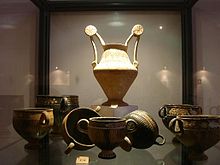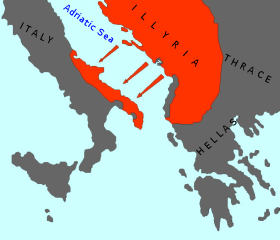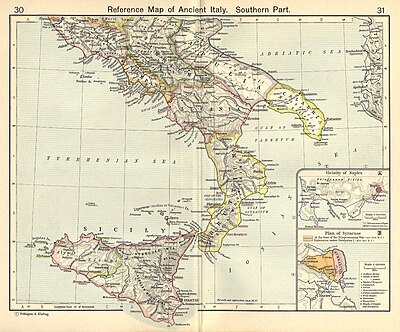
Messapic is an extinct Indo-European Paleo-Balkanic language of the southeastern Italian Peninsula, once spoken in Salento by the Iapygian peoples of the region: the Calabri and Salentini, the Peucetians and the Daunians. Messapic was the pre-Roman, non-Italic language of Apulia. It has been preserved in about 600 inscriptions written in an alphabet derived from a Western Greek model and dating from the mid-6th to at least the 2nd century BC, when it went extinct following the Roman conquest of the region.
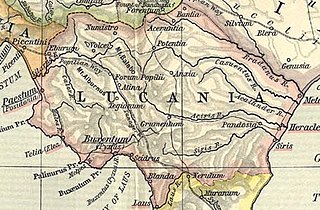
Lucania was a historical region of Southern Italy. It was the land of the Lucani, an Oscan people. It extended from the Tyrrhenian Sea to the Gulf of Taranto. It bordered with Samnium and Campania in the north, Apulia in the east, and Bruttium in the south-west, and was at the tip of the peninsula which is now called Calabria. It comprised almost all the modern region of Basilicata, the southern part of the Province of Salerno and a northern portion of the Province of Cosenza.

Salento, also known as Terra d'Otranto, is a cultural, historical and geographic region at the southern end of the administrative region of Apulia in Southern Italy. It is a sub-peninsula of the Italian Peninsula, sometimes described as the "heel" of the Italian "boot". It encompasses the entire administrative area of the province of Lecce, a large part of the province of Brindisi and part of that of Taranto.
The Battle of Beneventum was the last battle of the Pyrrhic War. It was fought near Beneventum, in southern Italy, between the forces of Pyrrhus, king of Epirus in Greece, and the Romans, led by consul Manius Curius Dentatus. The result was a Roman victory and Pyrrhus was forced to return to Tarentum, and later to Epirus.
The Battle of Pandosia was fought in 331 BC between a Greek force led by Alexander I of Epirus against the Lucanians and Bruttians, two southern Italic tribes. The Italic army soundly defeated the invading Greeks and killed Alexander I of Epirus during the battle.
The Iapygians or Apulians were an Indo-European-speaking people, dwelling in an eponymous region of the southeastern Italian Peninsula named Iapygia between the beginning of the first millennium BC and the first century BC. They were divided into three tribal groups: the Daunians, Peucetians and Messapians.
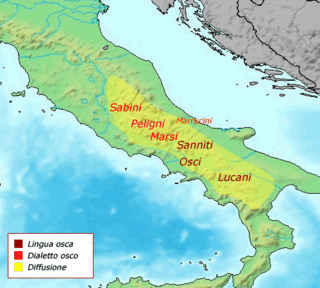
The Lucanians were an Italic tribe living in Lucania, in what is now southern Italy, who spoke an Oscan language, a member of the Italic languages. Today, the inhabitants of the Basilicata region are still called Lucani, and so is their dialect.

Oria is a town and comune in the Apulia region, in the province of Brindisi, in southern Italy. It is the seat of the Roman Catholic Diocese of Oria.
The origin of the city of Taranto dates from the 8th century BC when it was founded as a Greek colony, known as Taras.

Ceglie Messapica is a town, and comune, located in the province of Brindisi and region of Apulia, in southern Italy, in the traditional area called Salento.

Alezio is a town and comune in the province of Lecce in the Apulia region of south-east Italy.

The Peucetians were an Iapygian tribe which inhabited western and central Apulia in classical antiquity.
Illyrian religion refers to the religious beliefs and practices of the Illyrian peoples, a group of tribes who spoke the Illyrian languages and inhabited part of the western Balkan Peninsula from at least the 8th century BC until the 7th century AD. The available written sources are very tenuous. They consist largely of personal and place names, and a few glosses from Classical sources.
The Thunatae were a Dardanian tribe, along with the Galabri, mentioned by Strabo. The Thunatae are mentioned as neighbors of the Maedi, a Thracian tribe.
The Galabri were a Dardanian tribe, along with the Thunatae, mentioned by Strabo.

The socii or foederati were confederates of Rome and formed one of the three legal denominations in Roman Italy (Italia) along with the core Roman citizens and the extended Latini. The Latini, who were simultaneously special confederates and semi-citizens, derived their name from the Italic people of which Rome was part but did not coincide with the region of Latium in central Italy as they were located in colonies throughout the peninsula. This tripartite organisation lasted from the Roman expansion in Italy to the Social War, when all peninsular inhabitants were awarded Roman citizenship.

The Daunians were an Iapygian tribe that inhabited northern Apulia in classical antiquity. Two other Iapygian tribes, the Peucetians and the Messapians, inhabited central and southern Apulia respectively. All three tribes spoke the Messapic language, but had developed separate archaeological cultures by the seventh century BC.

The Iapygian–Tarentine wars were a set of conflicts and wars between the Greek colony of Taras and the three Iapygian peoples, the Messapians, Peucetians and Daunians.
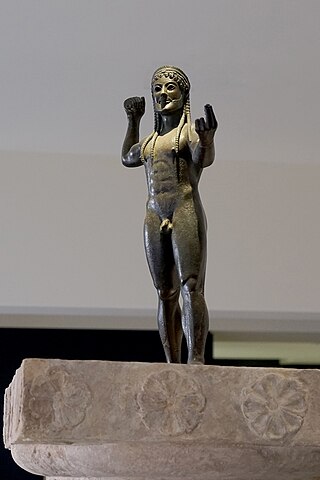
Zis is a sky and lightning god in Messapian religion. The theonym is the equivalent and cognate of Albanian Zojz and Greek Zeus, all from Proto-Indo-European *Di̯ḗu̯s 'sky god'. Zis appears in several votive inscriptions in the Messapic alphabet from Apulia.
